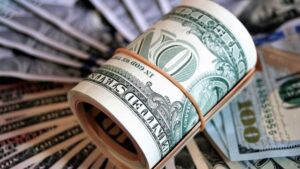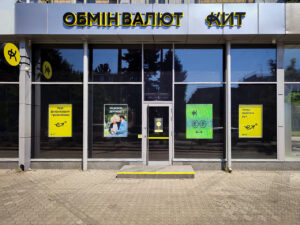
Issue #2 – August 2025
The purpose of this review is to provide an analysis of the current situation on the Ukrainian foreign exchange market and a forecast of the hryvnia exchange rate against key currencies based on the latest data. We analyze current conditions, market dynamics, key influencing factors, and likely scenarios.
Analysis of the current situation on the Ukrainian currency market
In the second half of August, a number of important signals from global markets confirmed that the hryvnia exchange rate increasingly depends not on local factors but on international news and the state of the world’s leading economies and the decisions of their central banks.
Domestic factors remain rather short-term impulses, capable of producing slight spikes but not changing the overall trajectory.
International context
In the United States, July data showed a slowdown in inflation and a cooling of the labor market. This took some pressure off the dollar and increased expectations that the Federal Reserve could cut rates as early as September. The Fed chairman explicitly acknowledged that the policy will have to be reviewed in order not to “overstretch” the economy. As a result, the dollar weakened slightly, and stock markets got a chance for additional optimism.
Given the expectations of the Fed’s actions regarding rate revisions, different scenarios should be considered for key currency pairs.
If the Fed cuts rates in September:
If the Fed leaves the rate unchanged:
The European economy looks sluggish: growth is almost imperceptible, inflation is stable at 2%, and there are no new drivers for the euro. This keeps the currency in a neutral mode – no reason for a breakthrough, but also no prerequisites for a sharp fall.
The UK was the first major economy to cut its interest rate. This signaled to the world that the period of tight monetary policy is coming to an end. If the United States confirms a similar move, the yield differential between currencies will decrease, and the dollar will lose some of its advantage.
Oil and gas prices remained relatively calm in August. This means that there is no additional pressure on the US and European economies due to energy. This is even more of a disadvantage for the euro, as the argument for a tighter ECB policy disappears.
In general, the international backdrop looks like this: The dollar has temporarily lost some of its support, and the euro is hovering on the sidelines.
For the hryvnia, this means relatively stable conditions.
Domestic Ukrainian context
The NBU’s reserves remain high, even after significant interventions and external debt repayments. This creates a safety margin to smooth out exchange rate fluctuations.
In July, inflation eased to 14.1% year-on-year, and the monthly figure showed deflation for the first time in two years. This calmed the market and reduced the “insurance premium” in prices.
External support is coming in as planned: at the end of August, the next tranche of more than €3 billion under the Ukraine Facility program and €1 billion from the proceeds of frozen Russian assets under the G7 Extraordinary Revenue Acceleration for Ukraine (ERA) initiative were disbursed. This is an important stabilizing factor for both the budget and the FX market.
The NBU has also taken steps to liberalize the currency by allowing the repatriation of dividends and expanding hedging instruments. This creates a more predictable environment for business without putting any additional pressure on the exchange rate.
In general, the Ukrainian FX market is entering September in a calm mode: reserves are sufficient, inflation has cooled, and external funds are coming in at the right level.
Internal factors are rather short-term spikes, but the exchange rate will be determined by statements, events, and decisions from Washington and Brussels.
US dollar exchange rate: dynamics and analysis
The general characteristic of market behavior is a smooth decline without sharp impulses
August confirmed the trend of gradual depreciation of the dollar against the hryvnia.
Domestic demand remains restrained: importers are working as planned, households are mainly focused on the euro, and the NBU is keeping the exchange rate in balance without any sudden movements.
Key influencing factors:
Forecast:
Euro exchange rate: dynamics and analysis
General characteristics of market behavior
The end of August showed more volatility for the euro than for the dollar. During the week, the exchange rate initially declined (to lows of ~47.80 UAH/€ on the buy side and ~48.40 UAH/€ on the sell side on August 27-28), but recovered to the level of 48.20-48.60 UAH/€ at the end of the period (August 30-31). It was a technical rebound that was synchronized with movements in the EUR/USD pair on the global market after the Fed chairman’s statement.
Prior to the news from the US, the market had recorded a stabilization in the euro after the previous decline, but there were no drivers for a new trend or significantly different levels from the current target levels.
Key influencing factors
Forecast.
Recommendations: act in ranges, keep liquidity, hedge risks
Key universal ideas:
A universal strategy for everyone – flexibility, division of operations into parts, hedging.
For private investors and savers:
For speculative operations on USD/UAH and EUR/UAH:
This material was prepared by the company’s analysts and reflects their expert, analytical professional judgment. The information presented in this review is for informational purposes only and cannot be considered as a recommendation for action.
The Company and its analysts make no representations and assume no liability for any consequences arising from the use of this information. All information is provided “as is” without any additional warranties of completeness, obligations of timeliness or updates or additions.
Users of this material should make their own risk assessments and informed decisions based on their own evaluation and analysis of the situation from various available sources that they consider to be sufficiently qualified. We recommend that you consult an independent financial advisor before making any investment decisions.
REFERENCE
KYT Group is an international multi-service product FinTech platform that has been successfully operating in the non-banking financial services market for 16 years. One of the company’s flagship activities is currency exchange. KYT Group is one of the largest operators in this segment of the financial market of Ukraine, is included in the list of the largest taxpayers, and is one of the industry leaders in terms of asset growth and equity.
More than 90 branches in 16 major cities of Ukraine are located in convenient locations for customers and have modern equipment for the convenience, security and confidentiality of each transaction.
The company’s activities comply with the regulatory requirements of the NBU. KYT Group adheres to EU standards, having a branch in Poland and planning cross-border expansion to European countries.
https://interfax.com.ua/news/projects/1101270.html

Last week, the National Bank of Ukraine (NBU) reduced sales of dollars on the interbank market by $234.8 million, or 27.9%, to $607.8 million, according to statistics on the regulator’s website.
According to the data released by the National Bank, last week the negative balance of buying and selling of foreign currency by banks’ legal entities increased from $43.2 million on Monday to $103.1 million on Thursday, which is almost half as much as last week.
A similar situation was observed in the market of foreign exchange transactions of households: while on Saturday-Monday, sales of foreign currency exceeded purchases by $7.6 million, on Thursday it was $10.5 million, while last Thursday this figure reached $27.5 million.
While a week earlier, for the first time in a long time, a negative balance was recorded in the segment of non-cash transactions of households, last week households again sold more non-cash currency than bought it – by $2-5 million daily.
The official hryvnia exchange rate against the dollar strengthened from 41.3895 UAH/$1 to 41.3401 UAH/$1 last week.
The same dynamics was observed in the cash market, where the hryvnia strengthened by 3-5 kopecks last week: buying to about 41.37 UAH/$1, and selling to about 41.45 UAH/$1.
“The Ukrainian currency market in terms of the dollar is in a calm phase – international factors do not provide drivers for drastic changes, while dosed interventions and liberalization of the NBU maintain low volatility and market controllability,” experts of KYT Group, a major participant in the cash foreign exchange market, said.
According to their estimates, domestic demand is stable without any hype or accumulative drivers, importers act in a planned manner without provoking abnormal outbursts, and there are fewer or no “insurance” margins of market operators in the hryvnia-dollar quotes.
For the next 1-3 weeks, KYT Group expects the exchange rate to remain in the basic range of UAH 41.30-41.85/$1: a break below UAH 41.20/$1 is unlikely without a strong external catalyst, but short impulses are possible based on data from the US or news about external financing for Ukraine.
In the medium term, for 2-3 months, the company expects the exchange rate to be 41.50-42.20 UAH/$1 and adds that the expectation of the September Fed decision with a likely but far from guaranteed rate cut shifts expectations for quotes to the lower end of the corridor. At the same time, autumn budget payments and energy imports may push quotes up, but the start of the export season and its success is a strong stabilizing factor.
“If the scenario of increased uncertainty (security, economic indicators, political shifts) or deterioration of external revenues is realized, short exits to 42.30-42.40/$1 are likely,” KYT Group experts believe.

Issue No. 1 – August 2025
The purpose of this review is to provide an analysis of the current situation on the Ukrainian currency market and a forecast of the hryvnia exchange rate against key currencies based on the latest data. We analyze current conditions, market dynamics, key influencing factors, and likely scenarios.
Analysis of the current situation on the Ukrainian currency market
The first ten days of August and the beginning of the second were marked by a number of data and decisions that set the tone for the exchange rate in the coming weeks. As before, external factors dominate, while internal factors mostly generate situational impulses and slight volatility without changing the long-term trend.
International context
UNITED STATES. July inflation slowed to within expectations, with prices rising by 2.7% yoy and core inflation (excluding food and fuel) by 3.1%, fueling expectations of a Fed rate cut in September and giving the dollar a brief respite after strong macro statistics in previous periods. The labor market has also cooled: nonfarm payrolls were weaker and unemployment rose, further increasing the likelihood of a dovish scenario for the Fed. Taken together, these factors reduce the so-called USD tightening premium over the next few weeks, at least until the Fed makes clear signals about its future policy.
Eurozone. The flash estimate of the Harmonized Index of Consumer Prices (HICP) published by Eurostat for July was 2.0% y/y (stable), which preserves the ECB’s argument for gradual cautious easing later this year. The final GDP estimates for the two quarters confirmed weak but still positive growth. For the euro’s future trajectory, this is more of a neutral or moderately negative signal in isolation from other drivers, as there was no hawkish surprise.
The UK sent its own signal to the global currency tone – its central bank cut its policy rate by 25 bp to 4.0%, signaling the start of monetary policy rebalancing by other major economies outside the US and the euro area and creating expectations for a broader rate review, provided that other macro indicators confirm this policy. In general, such processes soften the dollar’s advantage in the basket of global currencies over the next 1-2 months, if the Fed moves in the same direction.
The global energy factor has not yet provided any impetus for key economies to revise their policies. Market expectations for oil prices have not changed dramatically, and current quotes fully reflect the news background of recent weeks: the supply/demand balance does not add to inflationary tensions in the EU, so it is not a factor that would force the ECB to tighten its policy. This will also work against further euro appreciation. The expected trajectory is for a neutral or moderately downward impact on the euro, provided there are no other signals or data that could restrain or reverse the current trend.
Thus, given the current international backdrop, the USD has fewer reasons and drivers to strengthen in the short term, while the EUR is more likely to experience a sideways move.
The key factors in the near term will be the September Fed rate decision and further actions by the central banks of the world’s major economies: the expected convergence of rates in the leading economies reduces the US yield advantage, which means that the dollar’s advantage is melting away, but the euro is not getting its new driver either.
Domestic Ukrainian context
Reserves and interventions. The National Bank of Ukraine’s international reserves remain high, despite the NBU’s significant foreign currency sales and debt repayments. Despite the decline, the reserve cushion remains sufficient to smooth out fluctuations and maintain a controlled exchange rate dynamic.
Inflation. In July, inflation slowed to 14.1% year-on-year (yoy), and for the first time in two years, deflation was recorded at -0.2% on a monthly basis. This reduces short-term price risks and inflationary premiums in the pricing of importers/retailers. For the hryvnia exchange rate, these factors are neutral or moderately calming, as they eliminate the arguments for a sharp “insurance” demand for the currency.
External support is coming in as expected, which supports the basic set of factors for a stable hryvnia scenario. The EU Council’s decision to disburse another fourth tranche of more than €3.2 billion under the Ukraine Facility is an important reinforcement of fiscal stability and FX liquidity for the fall months. This indirectly reduces the risks of hryvnia volatility in the foreign exchange market.
A new step in currency liberalization by the NBU is a positive signal of stable expectations of the market and the regulator. In early August, the NBU allowed the repatriation of dividends and expanded hedging instruments, as well as simplified a number of technical FX transactions. Structurally, this reduces market risks and improves predictability for businesses without a sharp additional demand for foreign currency, which also removes pressure on the exchange rate.
The Ukrainian market is entering the second half of August with a preserved exchange rate consensus: reserves are sufficient, external financing is confirmed, inflation has cooled, and liberalization is dosed and managed. Domestic factors will continue to give short bursts, but the overall direction will still be determined outside Ukraine – by international data and decisions, primarily those of the US and the EU.
US dollar exchange rate: dynamics and analysis
General characteristics of market behavior – calm and narrow corridor
In general, the Ukrainian FX market is in a calm phase: international factors do not provide drivers for sharp changes, while the NBU’s measured interventions and liberalization keep market volatility and manageability low. Domestic demand is not driven by hype or accumulative drivers, importers act as planned without provoking abnormal surges, and market operators’ “insurance” margins are smaller or practically absent in the UAH/USD quotes.
Forecast.
Euro exchange rate: dynamics and analysis
General characteristics of market behavior – reflection of the euro to hryvnia exchange rate on external factors
After a long, smooth slide in the buy range of 47.85 to 47.75 and sell range of 48.65 to 48.45, the exchange rate rebounded sharply on 13-14 October: buy range of 47.90 to 48.20 and sell range of 48.50 to 48.85. The official NBU exchange rate rose by a one-day jump from 48.0758 to 48.6472, up UAH 0.58.
A steady downward trend was observed for thirty days, which was interrupted by a corrective recovery on August 13-14.
For most of the period, market rates were equidistant from the official one (the classic corridor), and the bid/ask spread remained at ~0.50-0.70 UAH/€, a sign of stable expectations and lack of nervousness.
The recorded rebound was the result of an external impulse (movement in the EUR/USD pair on the global market after the US statistics) and was quickly reflected in the EUR/UAH market quotes.
Such episodes do not indicate an imbalance, but only the expected technical alignment between the external and internal markets without changing the overall trend – data from the US and eurozone statistics allowed the EUR to make a technical rebound, but the market has already played off this momentum, so without new significant data from the US or the EU, we should not expect further growth in the euro against the hryvnia.
Domestic demand will also not be able to drive the growth of quotations due to the speculative component of setting rates by market participants – after the overheating of June and July and the exhaustion of effective demand, interest in cash euros has cooled. Importers are acting in a planned manner, which smooths out the overall pressure on the market and helps to normalize spreads.
Forecast.
Recommendations: act in ranges, keep liquidity, hedge risks
Key universal ideas:
– On the short term: USD has fewer reasons to strengthen, EUR is more likely to be sideways with technical bounces.
– Liquidity over profitability: keep a stock of free currency for current needs, term instruments only with the option of early access with minimal losses.
– A universal strategy for everyone – flexibility, trenching, hedging.
– Plan in ranges, not points: include exchange rate corridors in your calculations and forecasts, not fixed numbers.
– Keep an eye on spreads: this is now a more important indicator than the exchange rate. Narrowing is the moment to optimize purchases/sales, while widening is a signal to slow down.
– Risk management: Avoid large transactions and fixed commitments, avoid decisions based on emotions after news/social media – in the context of exchange rate calm, the media are trying to “squeeze clickbait out of nothing.”
For private investors and savers:
For speculative operations on USD/UAH & EUR/UAH:
– It’s time for short positions and quick action: record profits regularly in “small portions” and cut losses quickly.
– Watch out for “intersections” between the official and the market: a sudden jump in the official rate and narrowing spreads usually mean a technical lag and a quick “catching up” of the market – an opportunity for short positions / profit taking.
– Take care of liquidity: refrain from transactions or make smaller trades in an illiquid market (narrow choice of profitable offers, wide spreads), do not hold large positions before the release of important news.
This material was prepared by the company’s analysts and reflects their expert, analytical professional judgment. The information presented in this review is for informational purposes only and cannot be considered a recommendation for action.
The Company and its analysts make no representations and assume no liability for any consequences arising from the use of this information. All information is provided “as is” without any additional guarantees of completeness, obligations of timeliness or updates or additions.
Users of this material should make their own risk assessments and informed decisions based on their own assessment and analysis of the situation from various available sources that they consider to be sufficiently qualified. We recommend that you consult an independent financial advisor before making any investment decisions.
REFERENCE
KYT Group is an international multi-service product FinTech platform that has been successfully operating in the non-banking financial services market for 16 years. One of the company’s flagship activities is currency exchange. KYT Group is one of the largest operators in this segment of the financial market of Ukraine, is included in the list of the largest taxpayers, and is one of the industry leaders in terms of asset growth and equity.
More than 90 branches in 16 major cities of Ukraine are located in convenient locations for customers and have modern equipment for the convenience, security and confidentiality of each transaction.
The company’s activities comply with the regulatory requirements of the NBU. KYT Group adheres to the EU standards, having a branch in Poland and planning cross-border expansion to European countries.

In July, the National Bank of Ukraine (NBU) increased its sales of foreign currency on the interbank market by $873.6 million, or 30.9%, to $3.69 billion, according to statistics on the regulator’s website.
According to the statistics, the National Bank’s purchases of foreign currency in July fell to $0.83 million from $1.2 million in June, and last week the NBU’s foreign exchange interventions decreased by $171.9 million, or 21.2%, to $639.6 million compared to the previous week.
In July, the official hryvnia to dollar exchange rate strengthened from 41.7788 UAH/$1 to 41.7662 UAH/$1.
In the cash market, the hryvnia exchange rate strengthened by almost 13 kopecks over the month: buying at around 41.48 UAH/$1, selling at 41.58 UAH/$1.
“In July, the dollar to hryvnia exchange rate continued to demonstrate high stability with insignificant intraday volatility that did not turn into trend movements,” said experts from KYT Group, a major participant in the cash foreign exchange market.
They point out that the exchange rate fluctuations do not exceed 0.2%, which indicates an extremely restrained market reaction – especially given the announcement of important macroeconomic signals.
In their opinion, in the short term (one to three weeks), the corridor of 41.40-42.10 UAH/$ will remain in place in the absence of external shocks or surges in demand from importers.
KYT Group analysts expect that in the medium term (up to three months) the exchange rate may gradually shift to 42.30-42.80 UAH/$ in the face of the traditional growth in budget expenditures in the second half of the year, increased imports, or the implementation of the expected September Fed rate cut, which will lead to a correction of the dollar.
In the long term (over six months), experts predict a controlled devaluation trend. According to the baseline scenario, the exchange rate is expected to be in the range of UAH 43.00-44.50/$, provided that the current level of international support, stable reserves, and no unexpected shocks, especially those of a non-economic nature, are maintained.

Last week, the National Bank of Ukraine (NBU) increased its sales of foreign currency on the interbank market by $228.1 million, or 33.6%, to $906.6 million, according to statistics on the regulator’s website.
According to the statistics, this is the largest volume of currency sales since mid-February 2025, when the regulator sold a record $1191.30 million since the beginning of the year.
The data that the NBU has published during this time show that last week the balance of foreign exchange interventions was negative almost every day, except for Monday, when it amounted to $1.38 million. Already on Tuesday, the negative balance was recorded at $11.5 million, on Wednesday – $14.5 million, and on Thursday – $6.8 million.
The official hryvnia exchange rate against the dollar strengthened from 41.7842 UAH/$1 at the beginning of the week to 41.7514 UAH/$1 at the end.
On the cash market, the hryvnia strengthened by 5 kopecks over the week: buying to about 41.61 UAH/$1, and selling to about 41.70 UAH/$1.
“In July, the dollar to hryvnia exchange rate continued to demonstrate stability with a slight correction in a narrow range,” said experts from KYT Group, a major participant in the cash foreign exchange market .
In their opinion, in the short term (two to four weeks), the corridor of UAH 41.40-42.10/$ will remain in place in the absence of external shocks or surges in demand from importers.
KYT Group analysts predict that in the medium term (two to four months), the hryvnia exchange rate may gradually depreciate to 42.20-42.80 UAH/$ in the event of increased domestic budget spending, seasonal demand for the currency, or increased devaluation expectations among households and businesses.
In the long term (more than six months), experts do not expect a reduction in external financial support, so the most likely scenario is a gradual controlled devaluation of the hryvnia to 43.00-44.50 UAH/$. At the same time, the NBU’s exchange rate policy and the government’s signals on the macroeconomic course for 2026 may remain important deterrents.
https://interfax.com.ua/news/economic/1089251.html

KYT Group, one of the leaders in the currency exchange and financial services market in Ukraine, continues to dynamically expand its network in key cities of the country with high economic activity.
In Dnipro, the 99th branch of the KYT Group brand network, which has a national coverage and covers 31 settlements of Ukraine: from large metropolitan areas to cities with high economic activity, welcomes its first customers.
This is the sixth branch directly in Dnipro city and the ninth within the region, where one branch operates in Kamianske and two more in Kryvyi Rih. Expansion of KYT Group network presence in Dnipro is a response to the consistently high demand among the city and region residents for transparent quality service and favorable conditions from the national leader in the field of currency exchange.
The new exchange office is located at 90 Nauky Avenue, Dnipro, in a convenient location with active pedestrian traffic. The outlet adheres to the standard working hours for the network in all locations of its presence – from 09:00 to 19:00 seven days a week. Additional information about courses and services is available on the regional website of the KYT Group brand network kyt-obmin.dp.ua, by calling the customer support number of Dnipro city and region 0 800 33 20 57 or on the official telegram channel of the KYT Group network in the region @obmenka_dneprua.
Dnipro city is one of the strategic regions of presence of the KYT Group network of currency exchange offices as one of the largest industrial and economic centers of Ukraine.
Clients of the network in Dnipro and the region, as well as throughout the country, have access to key advantages and service options
Ø online fixing of the exchange rate for 60 minutes via the official website, telegram channel or the company’s customer support service – a unique solution for the Ukrainian market that allows you to plan an exchange in advance at the most favorable terms even in the face of a fluctuating exchange rate;
Ø special conditions for wholesale currency exchange – convenient for clients with large volumes of transactions seeking the most favorable offer.
The geographical expansion of KYT Group’s presence is aimed at providing Ukrainians with even wider access to services that meet the highest industry standards.
The new branch of the network in Dnipro city is decorated in the updated visual identity of the brand. This is part of the large-scale rebranding of KYT Group, which emphasizes the position of an innovative leader in the non-banking financial services market, which is constantly working to improve services and digital infrastructure and enhance customer experience, while remaining a reliable partner for Ukrainians in the field of foreign exchange transactions.
During 2024-2025, the KYT Group network is actively investing in expanding its geographical presence as a national leader in the currency exchange segment. New branches of the network were previously opened in Chernivtsi, Ivano-Frankivsk, Zhytomyr, Kamianske, Uman, Chernihiv, Dnipropetrovs’k and Kyiv regions.
REFERENCE
KYT Group is an international multiservice product-based FinTech platform with currency exchange as its flagship business. KYT Group is one of the largest operators of this segment in the Ukrainian financial market. According to data of the National Bank of Ukraine, KYT Group’s currency exchange network ranks first in the industry ranking in terms of taxes paid, capital, and business success in terms of financial results. The network of 98 exchange offices of KYT Group covers 31 of the largest cities of Ukraine and settlements with high business and economic activity. The company’s operations comply with the NBU’s regulatory requirements.
KYT Group’s long-term efforts to achieve leadership positions, improve services, customer and IT infrastructure have been recognized by the prestigious Banker Awards 2024 in the nomination “ Reliable Technology Partner for Exchange Operations”, as well as the award “Financial Market Leader” among non-bank financial institutions according to the “TOP-100. Ratings of the largest”.